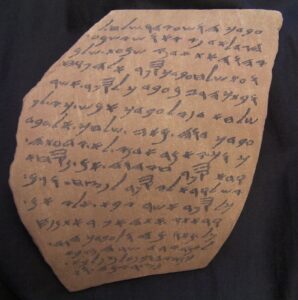On January 29, 1935, during the third season of excavations at Tell ed-Duweir, a site thought to be Biblical Lachish, archaeologists discovered a collection of 18 ostraca, or inscribed potsherds. The ostraca had been covered by a thick layer of destruction debris on the floor of a guardroom in the upper gate. The archaeologists credited the Babylonians, led by Nebuchadnezzar, with this destruction layer. In about 588 B.C., Nebuchadnezzar attacked Lachish just before he assaulted Jerusalem in 586 B.C., totally destroying that city and the First Temple. Later, three more ostraca were found at Lachish, making a total of 21.
The Lachish ostraca, or “The Lachish Letters” as they were called by Professor N. H. (Harry) Torczyner (Tur-Sinai), who was the first to decipher and interpret them, made an immediate splash in the scholarly world. Less than one month after their discovery, Sir Charles Marston, writing from Jerusalem to the Palestine Exploration Quarterly, proclaimed- “it is premature to suggest the precise effect that this find will have on old [sic!] Testament scholarship … But it already seems quite evident that further important evidence has been found that will tend to confirm the Old Testament…”
The letters clearly constituted some kind of correspondence and name lists.
Read the rest of Scholars’ Corner: Yadin Presents New Interpretation of the Famous Lachish Letters in the online Biblical Archaeology Society Library.
